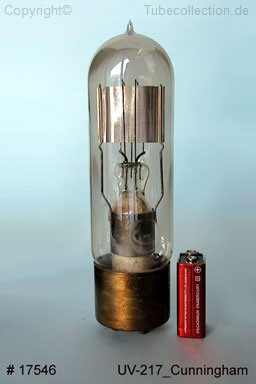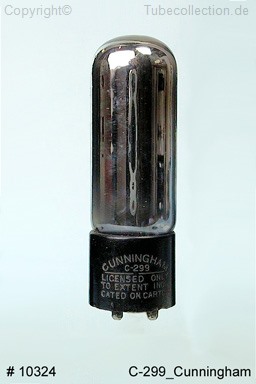|
Elmar T. Cunningham begann seine Produktion in Oaland, Kalifornien, USA in 1915. Er wurde bekannt durch sein "Audiotron". Den Namen ließ er sich 1916 in verschiedenen Schreibweisen schützen. Audiotron, AudioTron, Audio Tron Es war im Prinzip ein Glasrohr von 15..22mm Durchmesser und einer Länge von 75..90mm, mit einer zylindrischen Anode, einem spiralförmigen Gitter und einem Heizfaden aus Tungsten. Die Kennzeichnung erfolgte zunächst durch eine bedruckte Papierbanderole, später durch Gravur im Glas. Es begann ein Patentstreit zwischen DeForest und der Audiotron - Verkaufsgesellschaft, der jedoch später beigelegt wurde. Um seine Kompetenz zu beweisen brachte DeForest 1916 ein eigenes Tubular Audion mit einem Faden, die Type T, heraus. Es hat auf dem Anodenzylinder die Zeichen "D.F." Während des ersten Weltkrieges durften Funkamateure ihre Apparate nicht mehr benutzen und so brach der Markt für Audiotrons ein. Erst wieder ab 1919 erschienen weitere Anzeigen in Fachzeitschriften. In 1919 wurde von RCA ein Prozess gegen Cunningham geführt, der in Lieferverträgen endete. Ab 1920 wurden nach der Spezifikation von Cunningham Audiotrons von RCA geliefert, jedoch unter Cunningham vertrieben. Spätere Röhren tragen die üblichen amerikanischen Typenbezeichnungen. C-301 für eine UV-301 und CX-301 für eine UX-301. Wie lange Cunningham noch produzierte ist mir nicht bekannt. Jedoch erschien noch 1934 das Buch: 1934 Valve Data/History Books: RCA Cunningham Radiotron Manual - Technical Series RC-12. Weitere Informationen zu "Audiotro"-ähnlichen Röhren here |
Elmar T. Cunningham started his production in Oakland, California, at the west coast of USA. in 1915. He got known by the products brand name "Audiotron" which was registered in 1916 also for: Audiotron, AudioTron, Audio Tron The tubes had a diameter of 16..22mm and a lenght of 75..90mm. The anode consists of an open ring of aluminium, outer diameter corresponding to the inner diameter of the glas bulb. By this ist i fixed in a safe position and can conduct the heat to the glas cylinder. The V-shaped filament has 3 terminals and the grid is spiral shaped, made of copper wire. Some "Audiotrons" had black, some are red paper lables around the bulb. Others had an edged lettering. After the Audiotron appeared, DeForest filed suit against the Audiotron Sales Company. To demonstrate his competition he made in 1916 a type T tubular audion with one filament . On the anode cylinder was punshed the marking "DF" for DeForest. Dureing WWI the radio amateurs where not allowed to use their equipment and by this the marked for audiotrons broke down. First in 1919 appeared further advertising in professional journals In 1919 RCA filed suit against Cunningham, infringing the Fleming and de Forest patents. This ended in an agrement and contract. From 1020 Audiotron where supplied to Cunninghams specifications. The tube designations of later tubes adopted the letter "C". C-301 was for UV-301 and CX-301 was for UX-301. How long Cunningham produced, I don`t know. But in 1934 appeared the following book in the market. 1934 Valve Data/History Books: RCA Cunningham Radiotron Manual - Technical Series RC-12 Further details on "audion" shaped tubes are here |
| Weitere Infos zu Cunningham: https://en.wikipedia.org/wiki/Elmer_T._Cunningham |




